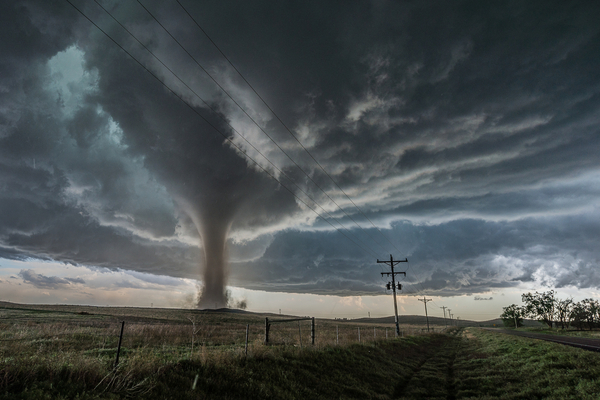On average, 1,200 tornadoes hit the United States each year, according to the Storm Prediction Center (SPC), and while twisters can happen at any time and in any state, the prevailing wisdom has held that most of the large twisters occur in Tornado Alley, an expansive area within the central U.S. designated by meteorologists in the mid-20th century. That definition may be changing.
As AccuWeather reports, the term Tornado Alley was coined in 1952 when two meteorologists studied severe weather in parts of Texas and Oklahoma. The research paper, titled “Tornado Alley,” was published by two U.S. Air Force meteorologists — Major Ernest J. Fawbush and Captain Robert C. Miller, who created the first tornado forecast in 1948.
Since then, the term has stuck around as a way to describe the area that encompasses parts of Texas, Oklahoma, Kansas, Nebraska and South Dakota, where it was believed tornadoes are the most frequent. With powerful tornadoes decimating areas in the Midwest and the southeastern U.S. over the past 20 years, there now may be a reason to believe that Tornado Alley has shifted east.
“When you look at the trends in where tornadoes have occurred in recent years, it’s very clear that there have been more tornadoes farther south and farther east away from what people have typically known as the Tornado Alley across the Plains,” AccuWeather Chief Meteorologist Jonathan Porter explained.
Research Shows the Shift East
A study conducted in 2018 and published in the journal Nature showed that the ingredients required to produce long-lived twisters were flourishing more in the Mississippi River valley in the last 20 years than parts of the original Tornado Alley.
Furthermore, the paper says, the number of days with meteorological conditions conducive to tornadoes has declined for parts of the original Tornado Alley, while the number of tornado days has increased significantly east of the Mississippi River. “I believe it’s physically real that we’ve seen this increase in the mid-South region in the last 40 years,” said Dr. Harold Brooks, the senior research scientist at the National Oceanic and Atmospheric Administration (NOAA).
In February 2022, another research paper concluded that large tornado outbreaks have shifted geographically when considering the years from 1989 to 2019 vs. 1950 to 1980. According to the study, “spatial analysis of [large tornado outbreaks] reveals that their nucleus has been shifting to the Southeast during the recent 31 years compared to the earlier records.”
AccuWeather Lead Long-Range Meteorologist Paul Pastelok attributed tornadoes becoming more frequent to the east of Tornado Alley due to the lack of moisture in the original Tornado Alley, which can be traced back to the 20-year mega–drought gripping much of the Southwest.
“You’re going to see higher pressure aloft over the Southwest, and that will bring drier air into the Plains and force the storm track and the worst of the tornadoes to develop farther east into the Mississippi and Tennessee Valley,” Pastelok explained. “You’re going to need to break that drought to get more consistent action going on in Tornado Alley.”
Defining a long-term Tornado Alley is Not Easy
Defining Tornado Alley over a longer period of time is not something all meteorologists agree on. AccuWeather asked Brooks where he thought the most tornadoes occur and he pointed to his research paper from 2000 showing how many “tornado days per century” a point on Earth might experience.
“What you see, whatever time period you look at, is sort of an L-shaped feature that goes through the Plains and pivots… into the Southeast.” The highest concentration of tornadoes, he explained, shifts around in each 15-year period (as shown in the animation below), moving from Arkansas to Oklahoma, and back to Mississippi, but the overall coverage of tornadoes stays the same, and always has.
In the longer term, where exactly Tornado Alley actually lies remains up to meteorologists’ interpretation.
“There are a lot of different ways to slice and dice the data,” AccuWeather Meteorologist and Senior Weather Editor Jesse Ferrell says. “I think it’s fair to replace the ‘Ye Olde Tornado Alley’ map with the combined areas shown on AccuWeather’s ‘Shift in Tornado Alley’ map, which covers the entire period of record of consistent data, and is the most up to date. People just need to realize that tornadoes can occur outside of these areas, and although the area has shifted in the last 35 years from the Plains to the Southeast, it may shift again.”
—
Photo Credit: Cammie Czuchnicki / Shutterstock.com
